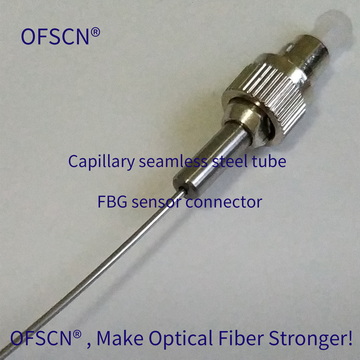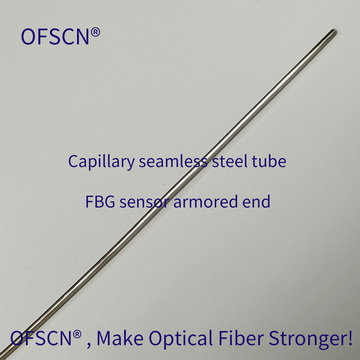Temperature monitoring is a crucial aspect of scientific research, particularly in processes that involve liquid-solidification. In such processes, it is essential to ensure that the temperature is maintained at optimal levels to ensure efficient and safe solidification. Fiber grating sensing technology has gained popularity in scientific research due to its accuracy, reliability, and versatility. In this article, we will discuss the problems that fiber grating sensing technology can solve, and how Beijing Dacheng Yongsheng Technology Co., Ltd.(short for DCYS ) can support temperature monitoring of liquid solidification process.
Fiber Bragg Grating Sensing Principle:
Fiber Bragg gratings (FBGs) are periodic structures that are inscribed in the core of an optical fiber. These structures reflect a specific wavelength of light that is determined by the periodicity of the grating. When the grating is subjected to mechanical or thermal strain, the reflected wavelength changes in a predictable manner. By monitoring the reflected wavelength, changes in strain, temperature, and other parameters can be detected. FBG sensors can be used to monitor a wide range of parameters, including strain, stress, temperature, and vibration.
Click the link below for more details:
Analysis of Demand for Temperature Monitoring in Liquid Solidification Process:
Temperature monitoring in liquid-solidification processes is essential in various scientific research fields such as material science, chemical engineering, and metallurgy. In such processes, it is crucial to monitor the temperature to ensure that the solidification process occurs efficiently and safely. Accurate temperature monitoring is also necessary to ensure that the desired material properties are achieved.

Why Temperature Monitoring of Liquid Solidification Process is Needed:
Temperature monitoring is crucial in liquid-solidification processes to ensure that the process occurs efficiently and safely. In scientific research, the temperature monitoring of liquid-solidification processes is essential to ensure that the desired material properties are achieved. Accurate temperature monitoring can also help in understanding the thermodynamic properties of the material being studied, leading to advances in scientific knowledge.

Difficulties in Temperature Monitoring of Liquid Solidification Process:
Temperature monitoring in liquid-solidification processes can be challenging due to the harsh conditions involved. Traditional temperature monitoring methods may not be accurate or reliable in such conditions. Additionally, temperature gradients within the material being studied can also affect the accuracy of the temperature measurements.

What Problems can be Solved by FBG Sensing Technology:
Fiber grating sensing technology can solve the accuracy and reliability issues associated with traditional temperature monitoring methods in liquid-solidification processes. Fiber grating sensors are highly sensitive, enabling accurate temperature measurements even in harsh conditions. Additionally, the use of fiber grating sensing technology allows for distributed temperature sensing, enabling the measurement of temperature gradients within the material being studied.
Recommended fiber grating temperature sensors:
Beijing Dacheng Yongsheng Technology Co., Ltd.:
Beijing Dacheng Yongsheng Technology Co., Ltd.(short for DCYS) is a professional manufacturer of fiber grating sensors, fiber grating demodulators and system software. Specializing in the production of various fiber grating sensors, including temperature, strain, stress, displacement, vibration, shape sensors, etc. DCYS also produces fiber grating demodulators, and can customize and develop related application software.
Recommended fiber grating demodulator:
Product Alias: Fiber Bragg Grating Interrogator, FBG Interrogator, FBG Sensor Interrogator, Fiber Optic Grating Interrogator, Fiber Bragg Grating Demodulator, FBG Demodulator, Fiber Optic Grating Demodulator
This product is produced by DCYS, and it is a high-speed high-frequency fiber Bragg grating demodulator(Interrogator). The fiber grating demodulator is compatible with various specifications and models of OFSCN® fiber bragg grating sensors (temperature, strain, stress FBG sensors, etc.). It features adjustable port density (4, 8, 16 channels) and high-speed high-refresh rate capabilities.
DCYS Helps to Monitor the Temperature of Liquid Solidification Process:
DCYS can provide fiber grating temperature sensors and demodulators that can be used for in-situ temperature monitoring during the liquid solidification process. DCYS's sensors have a high accuracy and resolution, making them suitable for scientific research. Furthermore, DCYS can customize and develop application software that meets the specific needs of the researcher.

Other Points Need to Be Clarified:
Apart from temperature monitoring, fiber grating sensing technology can also be used to monitor other physical parameters, including strain and pressure, in liquid-solidification processes. By monitoring these parameters, researchers can obtain a comprehensive understanding of the solidification process and the material properties being studied. Additionally, the use of fiber grating sensing technology allows for real-time temperature monitoring, enabling researchers to make necessary adjustments during the solidification process.
In conclusion, fiber grating sensing technology has proven to be an effective method for temperature monitoring in the scientific research of liquid solidification processes. With its ability to provide high accuracy, fast response time, and resistance to harsh environments, it can help researchers to better understand the complex physical and chemical processes involved in solidification.
Beijing Dacheng Yongsheng Technology Co., Ltd. is a reliable manufacturer of fiber grating temperature sensors and fiber grating demodulators, providing customized solutions for various research needs. DCYS's expertise and technology can help researchers overcome the difficulties and challenges of temperature monitoring in liquid solidification processes.
Overall, the application of fiber grating sensing technology in scientific research for temperature monitoring of liquid solidification processes has the potential to significantly advance our understanding of solidification processes and contribute to the development of new materials and technologies.
